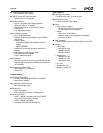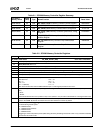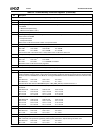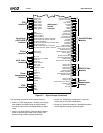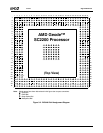
AMD Geode™ SC2200 Processor Data Book 23
Architecture Overview
32580B
2.3 Core Logic Module
The Core Logic module is described in detail in Section 6.0
"Core Logic Module" on page 149.
The Core Logic module is connected to the Fast-PCI bus. It
uses signal AD28 as the IDSEL for all PCI configuration
functions except for USB which uses AD29.
2.3.1 Other Interfaces of the Core Logic
Module
The following interfaces of the Core Logic module are
implemented via external balls of the SC2200. Each inter-
face is listed below with a reference to the descriptions of
the relevant balls.
• IDE: See Section 3.4.9 "IDE Interface Signals" on page
63.
• AC97: See Section 3.4.14 "AC97 Audio Interface
Signals" on page 68.
• PCI: See Section 3.4.6 "PCI Bus Interface Signals" on
page 57.
• USB: See Section 3.4.10 "Universal Serial Bus (USB)
Interface Signals" on page 64. The USB function uses
signal AD29 as the IDSEL for PCI configuration.
• LPC: See Section 3.4.8 "Low Pin Count (LPC) Bus Inter-
face Signals" on page 62.
• Sub-ISA: See Section 3.4.7 "Sub-ISA Interface Signals"
on page 61, Section 6.2.5 "Sub-ISA Bus Interface" on
page 155, and Section 4.2 "Multiplexing, Interrupt Selec-
tion, and Base Address Registers" on page 76
• GPIO: See Section 3.4.16 "GPIO Interface Signals" on
page 70.
• More detailed information about each of these interfaces
is provided in Section 6.2 "Module Architecture" on page
150.
• Super/IO Block Interfaces: See Section 4.2 "Multi-
plexing, Interrupt Selection, and Base Address Regis-
ters" on page 76, Section 3.4.5 "ACCESS.bus Interface
Signals" on page 57, Section 3.4.13 "Fast Infrared (IR)
Port Interface Signals" on page 67, and Section 3.4.12
"Parallel Port Interface Signals" on page 66.
The Core Logic module interface to the GX1 module con-
sists of seven miscellaneous connections, the PCI bus
interface signals, plus the display controller connections.
Note that the PC/AT legacy signals NMI, WM_RST, and
A20M are all virtual functions executed in SMM (System
Management Mode) by the BIOS.
• PSERIAL is a one-way serial bus from the GX1 to the
Core Logic module used to communicate power-
management states and VSYNC information for VGA
emulation.
• IRQ13 is an input from the GX1 module indicating that a
floating point error was detected and that INTR should
be asserted.
• INTR is the level output from the integrated 8259A PICs
and is asserted if an unmasked interrupt request (IRQn)
is sampled active.
• SMI# is a level-sensitive interrupt to the GX1 module
that can be configured to assert on a number of different
system events. After an SMI# assertion, SMM is entered
and program execution begins at the base of the SMM
address space. Once asserted, SMI# remains active
until the SMI source is cleared.
• SUSP# and SUSPA# are handshake signals for imple-
menting CPU Clock Stop and clock throttling.
• CPU_RST resets the CPU and is asserted for approxi-
mately 100 µs after the negation of POR#.
• PCI bus interface signals.
2.4 SuperI/O Module
The SuperI/O (SIO) module is PC98 and ACPI compliant. It
offers a single-cell solution to the most commonly used ISA
peripherals.
The SIO module incorporates: two Serial Ports, an Infrared
Communication Port that supports FIR, MIR, HP-SIR,
Sharp-IR, and Consumer Electronics-IR, a full IEEE 1284
Parallel Port, two ACCESS.bus Interface (ACB) ports, Sys-
tem Wakeup Control (SWC), and a Real-Time Clock (RTC)
that provides RTC timekeeping.



